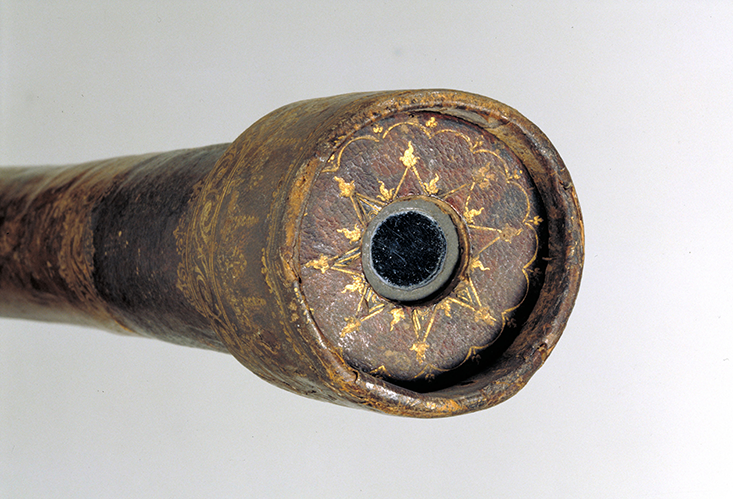by ALAN LIGHTMAN
 Seeing stars: Galileo’s telescope, which he used to view the heavens in 1610. The telescope is now in the collection of the Museo Galileo, in Florence. PHOTO/Fine Art Images/Heritage Images/Getty Images
Seeing stars: Galileo’s telescope, which he used to view the heavens in 1610. The telescope is now in the collection of the Museo Galileo, in Florence. PHOTO/Fine Art Images/Heritage Images/Getty Images
The advent of the telescope punctured our ideals about the nighttime sky.
I have in my hand a little book titled The Starry Messenger (Sidereus Nuncius in its original Latin), written by the Italian mathematician and scientist Galileo Galilei in 1610. There were 550 books in the first printing of Messenger. One hundred and fifty still remain. A few years ago, Christie’s valued each first edition at between $600,000 and $800,000. My paperback copy was printed in 1989 for about $12.
Although the history of science has not awarded Messenger the same laurels as Newton’s Principia or Darwin’s On the Origin of Species, I regard it as one of the most consequential volumes of science ever published. In this little book, Galileo reports what he saw after turning his new telescope toward the heavens: strong evidence that the heavenly bodies are made of ordinary material, like the winter ice at Lute Island. The result caused a revolution in thinking about the separation between heaven and earth, a mind-bending expansion of the territory of the material world, and a sharp challenge to the Absolutes. The materiality of the stars, combined with the law of the conservation of energy, decrees that the stars are doomed to extinction. The stars in the sky, the most striking icons of immortality and permanence, will one day expire and die.
Galileo was born in Pisa and grew up in Florence. From 1592, he taught mathematics at the University of Padua. Unable to discharge his financial responsibilities on his academic salary alone—he had to pay the dowries of his sisters in addition to supporting his three children by a mistress—he took in boarders and sold scientific instruments. In the late 1580s, he performed his famous experiments with motion and falling bodies. In 1609, at the age of 45, he heard about a new magnifying device just invented in the Netherlands. Without ever seeing that marvel, he quickly designed and built a telescope himself, several times more powerful than the Dutch model. He seems to have been the first human being to point such a thing at the night sky. (The telescopes in Holland were called “spyglasses,” leading one to speculate on their uses.)
Galileo ground and polished his own lenses. His first instruments magnified objects a dozen or so times. He was eventually able to build telescopes that magnified a thousand times and made objects appear 30 times closer than they actually were. You can see Galileo’s surviving telescopes in the rarely visited Museo Galileo, in Florence. His first one was 36.5 inches long and 1.5 inches wide, a tube made of wood and leather with a convex lens at one end and a concave eyepiece on the other. I recently looked out of a replica. First of all, I was surprised at how small the field of view was, appearing as a dime-sized circle of light at arm’s length at the end of a long tube. And dim. However, after squinting for a while, I could indeed make out the faint images in that dime of dim light. And when I trained the primitive telescope on a building a hundred yards away, I could see details in the bricks not visible to my naked eye.
Nautilus for more
